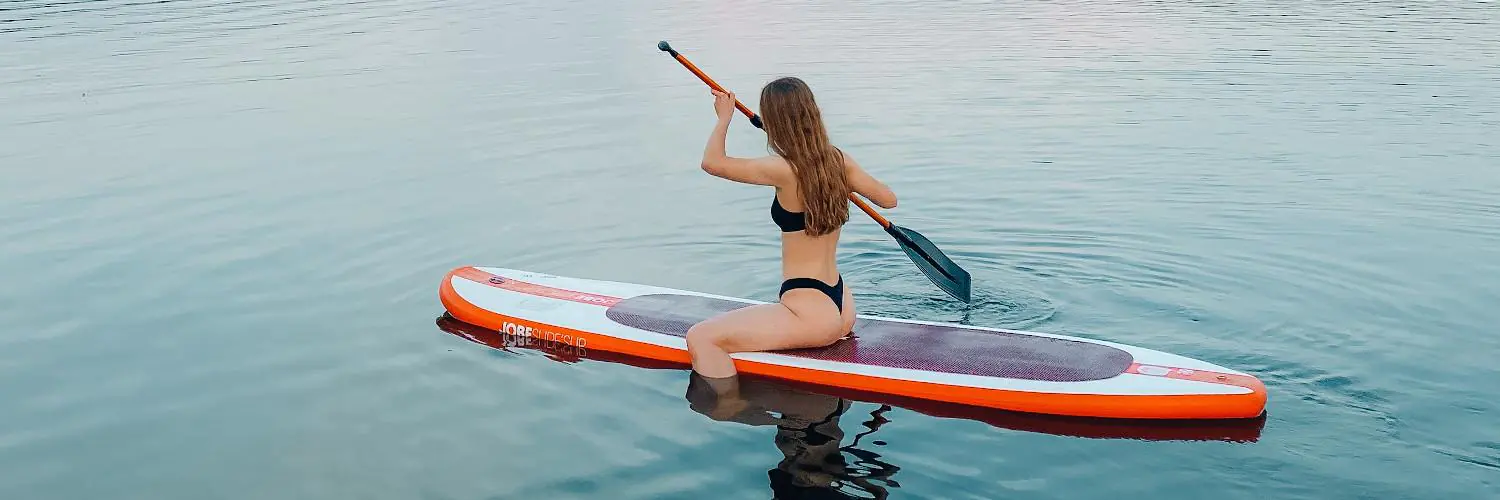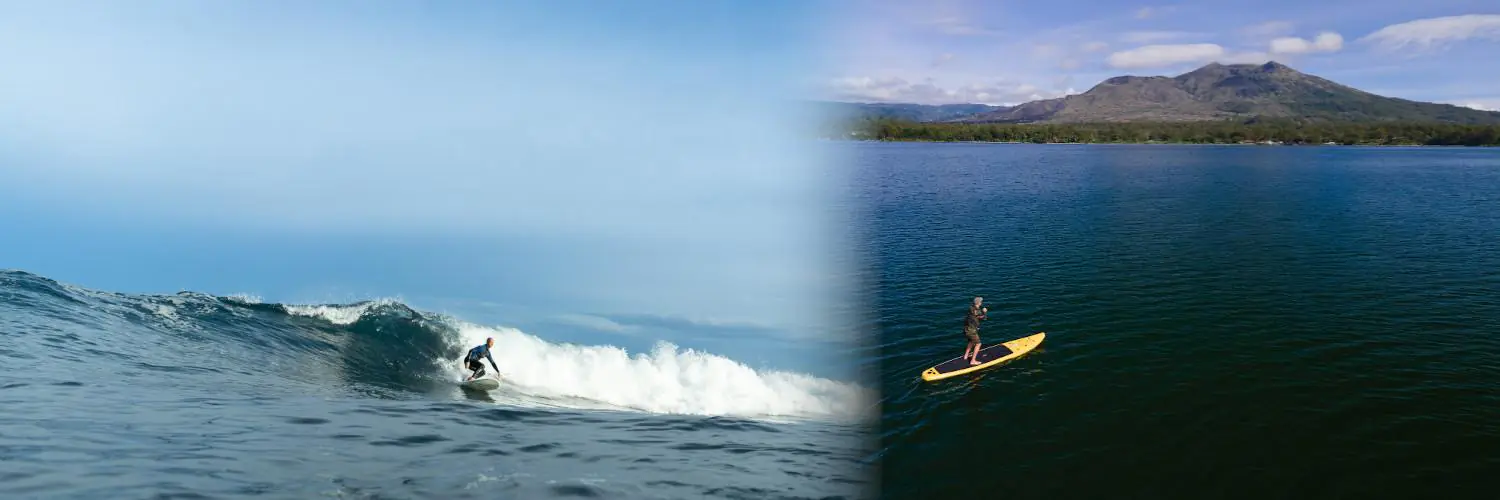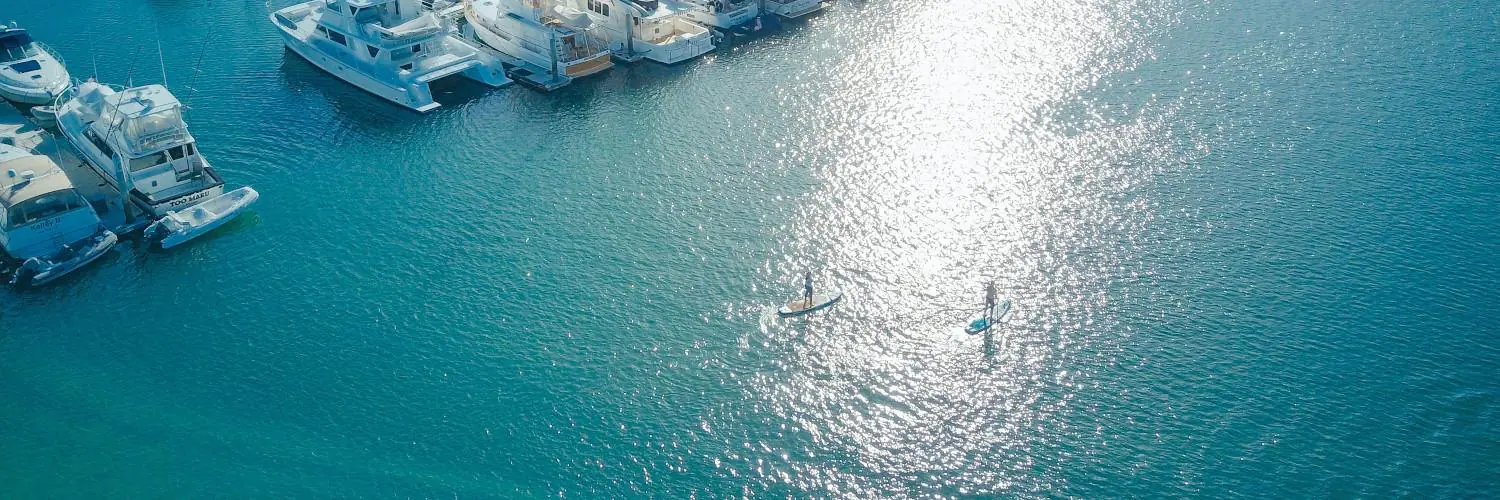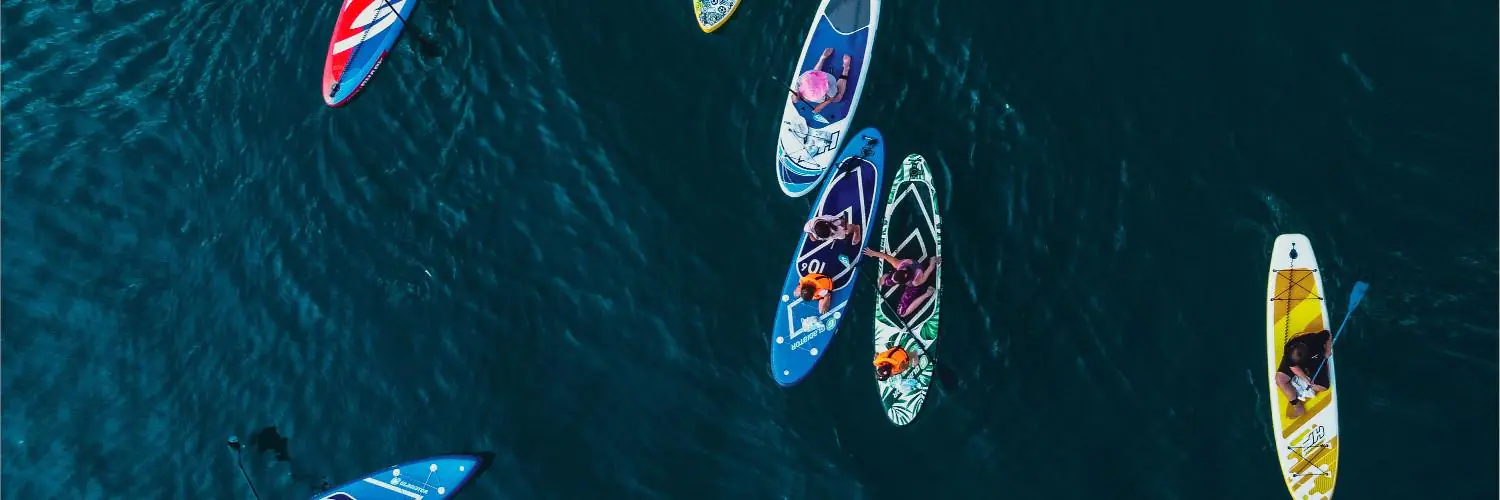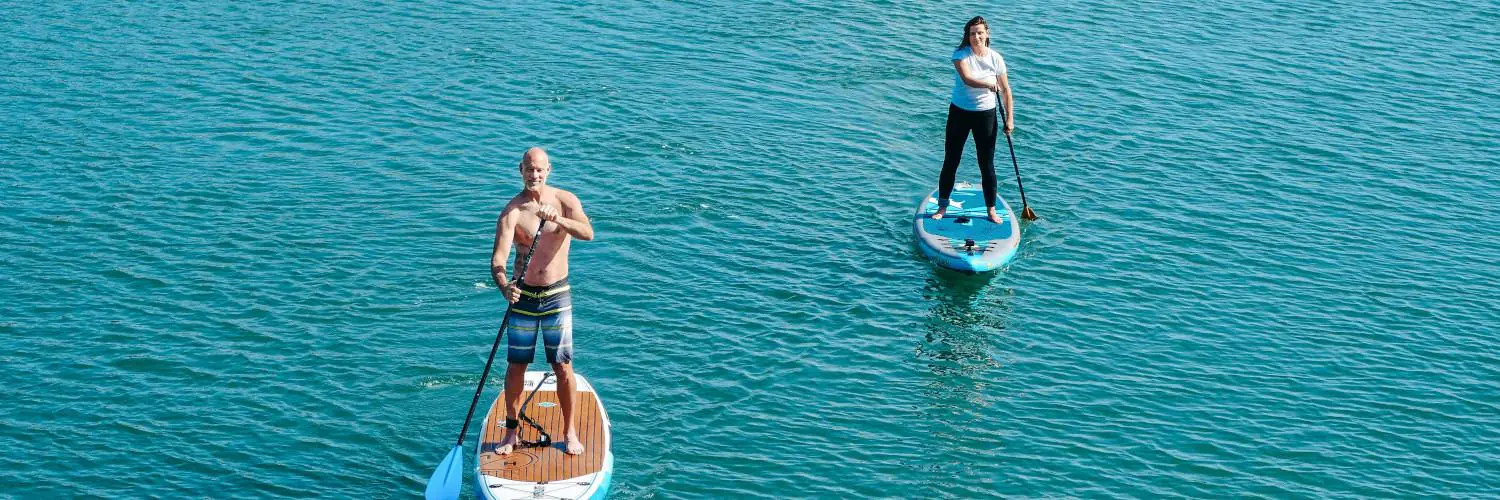Table of Contents
Expert Tips and Guidelines to Choose the Correct Size Stand Up Paddleboard
Purchasing a stand-up paddle board can be an exciting endeavor for water sports enthusiasts. With a variety of options available in the market, it’s essential to find the perfect paddle board that’s best suited for an individual’s needs. This guide helps you pick the right size paddle board.
There are several factors that one must take into consideration while choosing the right paddle board. These include the individual’s experience level, the intended use of the board, personal preferences for handling, and the physical dimensions of the board itself. Surely, knowing these important parts will help people buy better paddle boards and enjoy their trips.
It’s important to examine the shape, volume, capacity, length, width, and thickness of the paddle board while making the selection. These things affect how the board works, its steadiness, and how people feel using it. By checking these important qualities, people can choose the paddle board that suits them and makes their time on the water the best it can be.
Understanding Paddle Board Sizes
To pick the best paddle board, think about length, width, and thickness. These things affect how the board works and stays steady.
Length
Paddle boards come in various lengths, with different advantages:
- 8-10 Feet: These shorter boards are ideal for surfing, offering enhanced maneuverability.
- 10-12 Feet: These mid-sized boards suit beginners and intermediate users, providing stability for all-around use.
- 12+ Feet: Longer boards, such as these, are perfect for touring and racing, offering better tracking and speed.
Width
The width of a paddle board also affects stability and performance:
- Narrow (less than 30 inches): Narrow boards are faster but less stable, ideal for experienced users or racing.
- Medium (30-34 inches): These widths offer a balance between stability and speed, suitable for beginners and intermediate users.
- Wide (over 34 inches): Wider boards have increased stability but may be slower, suitable for beginners or those who prioritize balance.
Thickness
The size of the board affects how much it can float and hold:
- Thinner boards are light and easy to move but may not hold much weight.
- Thicker boards can carry more weight but might be harder to steer due to increased height affecting balance.
Volume
The volume of a paddle board affects its buoyancy and weight capacity:
- Low volume boards loat less and are good for light riders or riding waves.
- Mid volume boards offer a balance between buoyancy and maneuverability, suitable for a range of activities and skill levels.
- High volume boards have greater buoyancy and support more weight, making them ideal for heavier riders or carrying gear on touring expeditions.
By considering the length, width, thickness, and volume of a paddle board, you can find the perfect fit for your needs and skill level.
Selecting the Right Size Based on Activity
Recreational Paddling
For recreational paddling, a good starting point is a paddle board that is between 10 and 12 feet long and 32 to 34 inches wide. This ensures adequate stability for beginners while still providing decent speed for more experienced paddlers. Consider your weight and skill level when choosing a paddle board, as higher weight capacity boards may be more stable for larger individuals or those just starting out.
Touring
When selecting a touring paddle board, look for one that is over 12 feet long and has a displacement hull to help it glide smoothly and track straight. Add 10-12 inches to your height when choosing the perfect size SUP board for touring and racing. Longer boards provide better efficiency on long-distance paddles, but may be harder to maneuver for inexperienced paddlers.
Yoga and Fitness
For SUP yoga and fitness, you’ll want a stable board with sufficient width (at least 32 inches) to provide a solid platform for performing exercises. A soft-top or inflatable board can also be more comfortable for yoga and fitness activities. Prioritize balance and stability when choosing a SUP for yoga and fitness.
Surfing
When SUP surfing, a short board (around 8 feet) is more advantageous since it allows for enhanced maneuverability in the waves. Shorter boards may not be as stable as longer ones, so consider your skill level before opting for a very short board.
Racing
Racing paddle boards are designed for speed and tracking. They often feature a narrow width (around 26 inches) and a displacement hull. A longer board (around 14 feet) is preferred by racers because it provides better glide and straighter tracking. Keep in mind that racing boards may not be the best option for beginners due to their reduced stability.
Whitewater Paddling
Riding rough water needs a special SUP board with more curve and strong build to handle hits. Boards around 9 to 10 feet long with more space inside are good for this. They help move better and stay afloat in hard water. Ensure that the material and construction of the paddle board can handle the demands of whitewater paddling.
Fishing
A fishing SUP should be stable, with a wider width (34 inches or more) and a high weight capacity to accommodate fishing gear and potential catches. An added bonus is a board with built-in attachment points for fishing accessories like rod holders and cooler mounts. Consider the types of water you’ll be fishing in when choosing the right paddle board for this activity.
Matching Paddle Board Size to Rider’s Specifications
When selecting the right size paddle board, it’s essential to consider the rider’s specifications to ensure a safe and enjoyable paddling experience. This section will cover several critical factors, including weight capacity, height range, and experience level.
Weight Capacity
The weight capacity of a paddle board is crucial for maintaining stability and proper performance in the water. Most paddle boards have a maximum weight capacity listed in their specs to indicate the suitable rider weight range. Exceeding this weight limit may affect the board’s stability, buoyancy, and overall performance. Consider the following guidelines:
- Lightweight riders (under 150 lbs): SUP weight capacity of 150-200 lbs
- Average weight riders (150-220 lbs): SUP weight capacity of 220-260 lbs
- Heavyweight riders (over 220 lbs): SUP weight capacity of 260+ lbs
Note that these are general recommendations, and it’s always best to refer to the specific paddle board model for precise weight capacity details.
Height Range
A paddle board’s size should also correspond to the rider’s height. Tall people may need a bigger board for better balance, but short riders might do well with a smaller board for easier control. Here’s a general guideline for matching paddle board size with rider’s height:
- Short riders (under 5’8″): 9’6″-10’6″ length
- Average height riders (5’8″-6’3″): 10’6″-11’6″ length
- Tall riders (over 6’3″): 11’6″+ length
When considering board size, the width is also a crucial factor for stability. Beginners can choose a board with a width of 81 cm (32″) for added balance.
Experience Level
Finally, the rider’s experience level plays a significant role in selecting the proper paddle board size. Beginners should opt for an all-around paddle board that provides stability and versatility. An example is the 10’6″ x 32″ x 6″ (320 x 81 x 15 cm) model, a popular choice for first-timers.
As the rider gains experience, she might choose a narrower board to increase speed and tracking, such as a 384 cm long board with a 71 cm width. However, note that a narrower board will also be less stable, so make sure the rider has enough experience before making this switch.
For children or young riders, smaller and lighter paddle boards are recommended for easier handling and control.
Types of Paddle Boards and Materials
Solid Paddle Boards
Solid paddle boards, also known as hard paddle boards, are made from various materials such as foam, fiberglass, carbon fiber, plastic, and wood. These boards are known for their performance, speed, and stability. Generally, they have a higher weight limit and can offer a more versatile experience for different water conditions.
Solid boards with narrow shapes are suitable for experienced users who prioritize speed, such as for SUP racing. Wider boards provide more stability, making them ideal for recreational paddling and SUP yoga. Overall, solid paddle boards are recommended for individuals who require higher performance, speed, and a specific experience level.
Inflatable Paddle Boards
Inflatable stand up paddle boards are popular due to their portability and storage capabilities. Made from PVC and drop-stitch construction, these boards can be deflated when not in use, making transportation and storage easier. Inflatable paddle boards are excellent for recreational paddling, SUP touring, and waters with rapids, as they provide greater buoyancy and durability.
In comparison to solid boards, inflatables can be slower and may have a lower weight limit. However, their stability and medium performance level make them suitable for beginners and intermediate users. Inflatable paddle boards are generally more cost-effective compared to solid boards, making them an attractive option for those new to the sport.
Materials Used in Construction.
Boards are made of different stuff, each with good and not so good things. Here’s a quick look at usual materials:
- Foam: Light and cheap, foam boards are nice for new people. But, they might not last long or be great for good paddlers.
- Fiberglass: Many like fiberglass boards, they are strong and not so heavy. Fiberglass boards usually have foam inside for float and strength.
- Carbon Fiber: Known for its lightweight and strong properties, carbon fiber boards are suitable for SUP racing and expert-level paddlers. These boards can be more expensive due to the material’s high performance.
- Plastic: A durable and budget-friendly option, plastic boards are best suited for recreational paddling and rugged waters. They tend to be heavier and may have a slower speed.
- Wood: Wood looks nice, wooden boards may have foam or be hollow inside.
- Aluminum: Seen in some inflatable boards, aluminum strengthens the board but makes it heavier.
When choosing a paddle board, consider your experience level, desired performance, and budget. Different materials cater to varying needs, so understanding their properties will help you find the perfect board for your SUP adventures.
Additional Considerations for Buying the Right Size Paddle Board
Storage and Transport
When selecting the right paddle board size, consider the available storage space and transport options. It is essential to have a proper storage area to protect your board from damage and extend its lifespan. Some paddle boards are inflatable, providing a portable and compact option, while others have a solid foam core or veneer construction. In addition, think about how you will transport the board, since longer paddle boards may be more challenging to maneuver in tight spaces.
Safety and Agility
The safety and agility of your paddle board are crucial factors to consider. The right size paddle board will improve your balance, especially in choppy waters or rapids. Ideally, you want to choose a board that has a higher point of gravity, as it will provide you with better maneuverability during challenging conditions.
Customization Options
Some paddle boards come with options to customize them for specific uses, such as adding attachments or even changing the fin configuration. If you plan on using your board for different activities such as leisure paddling, surfing, or SUP yoga, consider a board size that allows for adjustments to suit your needs.
Price and Durability
Lastly, it’s essential to weigh the cost of your paddle board against its durability and features. In general, solid paddle boards tend to be more expensive but offer better performance, while inflatable paddle boards are more affordable and portable. When choosing the right paddle board size, take into account its durability, materials, and any additional features that may be important to you.
Closing Paragraph
In the end, finding the right size paddle board is crucial for an enjoyable and successful stand-up paddling experience. One should consider factors such as board length, width, thickness, and volume in relation to their body weight and skill level. For beginners, a wider and longer board is recommended for increased stability, while more advanced paddlers may opt for a narrower, faster board to enhance performance.
You must check and compare different paddle boards well to find the right one for you. Reading product reviews and consulting with experienced paddlers can provide valuable insights into the suitability of a particular paddle board size for a given person.
Remember, investing in a well-suited paddle board not only ensures a more enjoyable experience on the water but also reduces the risk of accidents and promotes the development of paddling skills over time.

